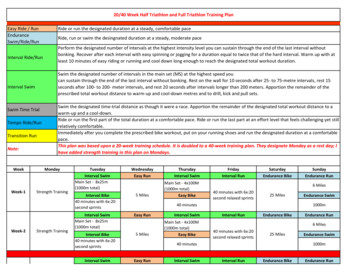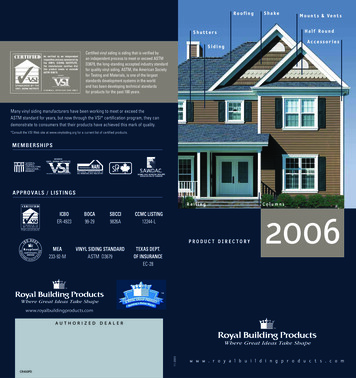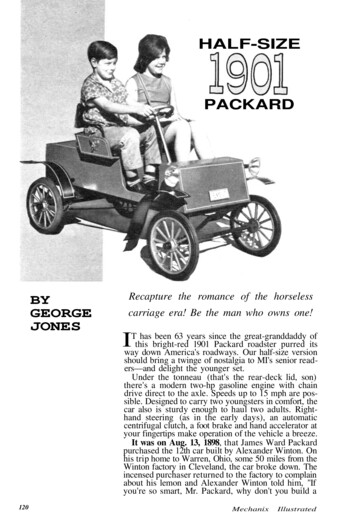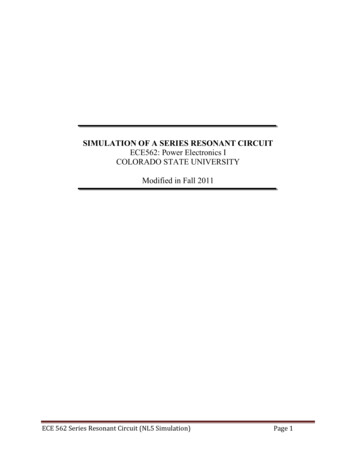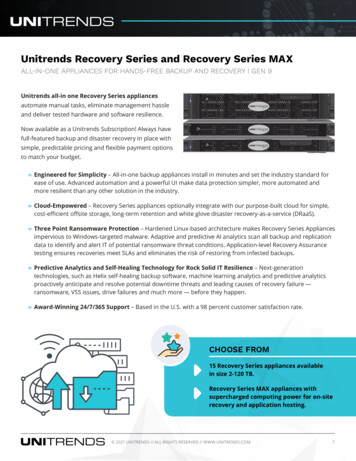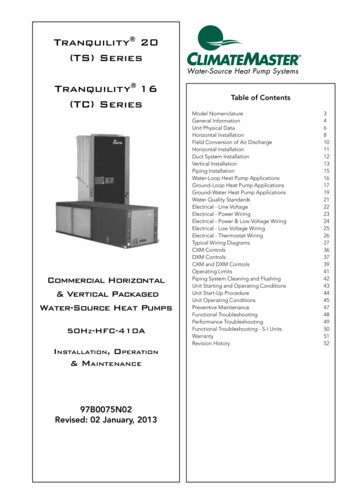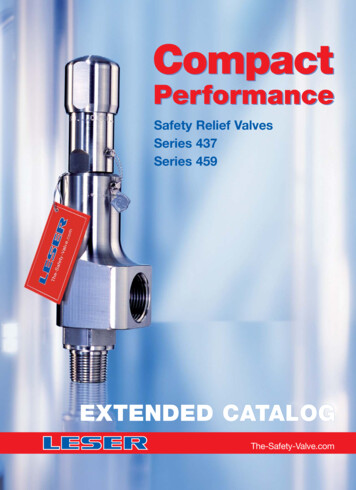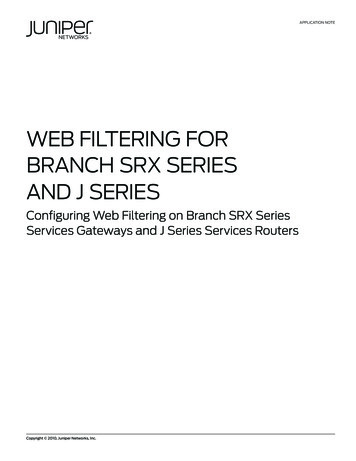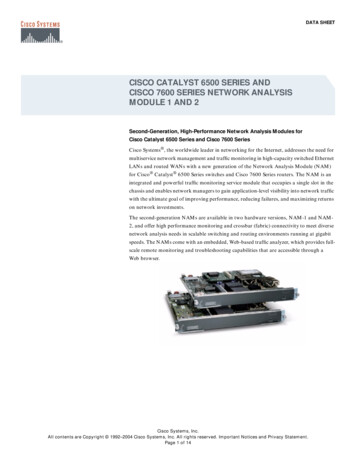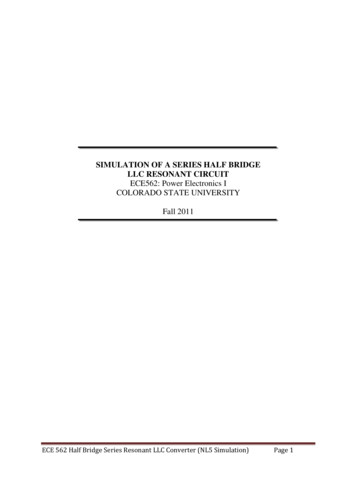
Transcription
SIMULATION OF A SERIES HALF BRIDGELLC RESONANT CIRCUITECE562: Power Electronics ICOLORADO STATE UNIVERSITYFall 2011ECE 562 Half Bridge Series Resonant LLC Converter (NL5 Simulation)Page 1
PURPOSE: The purpose of this lab is to simulate the LLC resonant converter usingNL5 to better familiarize the student with some of its operating characteristics.Two variants of the LLC converter are the series resonant converter and the parallelresonant converter. The LLC converter is series resonant when Cr is in series with themagnetizing inductance Lp/Lm of the transformer (shown below) and a parallelresonant converter when Cr is in parallel with the magnetizing inductance Lp/Lm asshown below.This lab will focus only on the behavior of the series resonant LLC converteroperation.The LLC converter is used with a transformer in either a full bridge or half bridgeconfiguration. To save on parts counts, lower power LLC converters will be of the halfbridge configurations as shown below (Two switches are used versus the fourswitches used in full bridge LLC). The LLC converter utilizes the magnetizinginductance of the transformer to construct a complex resonant tank with Buck Boosttransfer characteristics in the soft-switching region. The two switches operate at a50% duty cycle and the output voltage is regulated by varying the switching frequencyof the converter. The converter has two resonant frequencies – a lower (variable- dueto load R) resonant frequency (set by Lm, Lr, Cr and the load resistance) and a fixedhigher series resonant frequency Fr1 (set by Lr and Cr only). The two switches can besoft switched for the entire load range by operating the converter under the inductiveload region (ZVS region). It can be operated above or below the Fr1 higher resonantfrequency where Fr1 defines the boundary between region 2 and 3 (shown later).This lab will explore some of the following aspects of the half bridge series resonantconverter: Three regions of operation for LLC converter Frequency response of LLC converter Input impedance of the LLC tank Output voltage of the LLC tank Inductor currents of the LLC tank Zero crossing of inductors currents to find resonant frequenciesECE 562 Half Bridge Series Resonant LLC Converter (NL5 Simulation)Page 2
Output power of LLC tankThe graph below shows the three distinct regions that the series resonant LLCconverter can be operated in. Region 1 is soft switched (ZVS) region at a frequencyabove the frequency of the higher resonant tank circuit. Region 2 is also a soft switched(ZVS) region with a frequency between the resonant peaks of the two tanks circuits.Operation in region 3 is below the frequency of the peak of the lower tank circuit andcauses the converter to operate in the ZCS switching region (hard switching).ECE 562 Half Bridge Series Resonant LLC Converter (NL5 Simulation)Page 3
Figure 1 - Typical voltage conversion ratio of a LLC resonant converterThe following schematic shows a simplified series resonant half bridge LLC converter.The output is a tapped transformer followed by a half wave bridge rectifier.A technique called First Harmonic Approximation is sometimes used to simplify theanalysis of the converter. To convert the circuit below to its FHA equivalent, all thecomponents on the secondary side are put to the primary side. To accomplish this, allthe impedances on the secondary side are multiplied by the turns ratio squared to comeup with the equivalent primary side impedances. The DC switching (Square wave)voltages are converted to an AC sin wave which represents only the frequency andamplitude of the fundamental sine wave component of the Fourier transform of theswitching square wave.Figure 2 - Series resonant half-bridge LLC converterThe circuit below shows the simplified schematic showing a FHA equivalent of thecircuit above. The load resistor impedance has been multiplied by the turns ratio of theECE 562 Half Bridge Series Resonant LLC Converter (NL5 Simulation)Page 4
transformer and adjusted so that the AC power dissipation will be the same thedissipation as the circuit above. For detailed information on this conversion, please referto International Rectifier’s application note AN-1160.Figure 3 - The FHA (First Harmonic Balance) equivalent circuitNOTE: The simulations that follow are intended to be completed with NL5. It isassumed that the student has a fundamental understanding of the operation of NL5.NL5 can be found at http://nl5.sidelinesoft.com/MATLAB will be used later in the lab to solve additional parameters of the LLCconverter.Build the schematic in NL5 as shown in Figure 3 above Vfund is an AC voltage source. Set the type to ‘Sin,’ and the magnitude to 1 V.Cr is an ideal capacitor. Set to 22 nF.Lr is an ideal inductor. Set to 125 μH.Lm is an ideal inductor representing the magnetizing inductance of thetransformer. Set it to 500 μH.Rac is an ideal resistor. Set to 157 Ω.HINT: Press F3 (Schematics- components pull down) and adjust the names and valuesas needed. To adjust a name, select the component name and then select the upper left[a b] symbol. To select a value, select the component on the left column of componentsand then type a new value in the right side component value field.Figure 4 - Window (Press F3) to adjust name and values of componentsECE 562 Half Bridge Series Resonant LLC Converter (NL5 Simulation)Page 5
HINT: Rotate left or right, mirror or flip components as needed.After making name and component values adjustments, the First HarmonicApproximation of the series resonant LLC converter should look like the schematicbelow.Figure 5 - FHA representation of series resonant LLC converter in NL5Select AC- Settings and set the ‘AC Settings’parameters as follows:Figure 6 - AC parameter settings for FHA analysisNow Select AC- Data menu and set the ‘AC Data’ parameters as follows:Add a trace to display the Voltage of the Rac resistor.ECE 562 Half Bridge Series Resonant LLC Converter (NL5 Simulation)Page 6
(Hint: Select V in left column and Rac in middle column and select the green plus symbolbutton with the word ‘Add’ to add trace )Figure 7 - Parameter setting for AC- Data menuNow select the ‘Screen’ tab and ensure the Vertical scale ‘log’ check box is unselected.To plot in voltage instead of dB.Figure 8 - 'Screen' to uncheck ‘dB’ box and have the results displayed as voltage versus dB.ECE 562 Half Bridge Series Resonant LLC Converter (NL5 Simulation)Page 7
Figure 9 - Rac Output voltage response versus frequency of FHA model Comment on the converters voltage output versus frequency.How does it compare to Figure 1?Is the converter a Buck? Boost? Buck-Boost?Now let’s see how the series resonant LLC converter output voltage behaves with various loads.On the schematic, select the component that you want to sweep (Rac in this case).From the pull down menu select Tools - Script. Select the ‘sweep’ tab and under the ‘sweep’tab select the ‘list’ tab. Under ‘Name’ select the R.ac R from the pull down (It should be the onlyone listed ) Set up the Rac resistance values for the following values:[1, 10, 100, 200, 400, 1000]Select the blue ‘Run script’ arrow to see the results.Figure 10 - LLC series resonant converter with varying load values.ECE 562 Half Bridge Series Resonant LLC Converter (NL5 Simulation)Page 8
Looking at the voltage and phase response, can you identify the two separate tankcircuits? (Hint: It’s easiest to discern in the phase response)Does the load resistance affect either or both of the tanks circuits?Does the NL5 response match up to the typical voltage conversion ratio of a LLCresonant converter shown in the graph below?Figure 11 - Typical voltage conversion ratio of a LLC converterHint: To clear all the traces, select Transient- Data pull down menu, select the ‘storage’ tab andclick on the black middle left ‘X’ to delete all data traces from the display.ECE 562 Half Bridge Series Resonant LLC Converter (NL5 Simulation)Page 9
Now build the full half bridge series resonant converter shown below in NL5:Figure 12 - Series resonant half bridge LLC converter in NL5Hints:1) Select ‘Logic generator’ under the ‘Y’ component menu for Y22) Select ‘D trigger’ under the ‘Y’ component menu for Y33) Select ‘Logic-1’ under ‘Y’ menu for inverter component Y14) The half bridge transformer must be constructed of three individual ‘windings’ which canbe found under the ‘W’ component menu for {W1,W2 and W3}. Be sure to set W1 to 9 turnsfor the primary side of the transformer step down5) Use a regular inductor for the magnetizing inductance Lm of the ‘ideal’ transformer thatwas constructed out of individual windings. Connect the ‘core’ pins of the windingstogether along with the inductor representing the magnetizing inductance of thetransformer. (See NL5 manual snippit shown in Figure 13 for more information)ECE 562 Half Bridge Series Resonant LLC Converter (NL5 Simulation)Page 10
6) Set the ‘parameter’ of the Pulse to the following:7)8) Set all other components values to those shown on series resonant half bridge LLCschematic above.ECE 562 Half Bridge Series Resonant LLC Converter (NL5 Simulation)Page 11
Figure 13 - p378 of NL5 manual - Constructing arbitrary transformers with magnetizing inductor using the‘winding’ featureNow set the transient settings to the values shown below.Now select Transient - Data menu and add a new trace to plot the Voltage of component Cout.The converter response should look similar to below:ECE 562 Half Bridge Series Resonant LLC Converter (NL5 Simulation)Page 12
Select Tools - Script and run LLC converter and set to run pulse period from 5us to 160 us in20 us steps.Press the ‘Blue’arrow to start runs.Select the different tabs at the bottom of the data display to highlight each run. Describe the voltage response M(d) of the converter as the period is run from 1uS to 160uS in 10uSsteps. Is it as you expected?ECE 562 Half Bridge Series Resonant LLC Converter (NL5 Simulation)Page 13
What can you say about the converter’s frequency needed to run under (near) full loadconditions? Which region {1,2 or 3} is it operating in?Now set the pulse period for Y2 to 50uS (50e-6s)and sweep the Rac value from the 3 ohm nearfull load upwards to say 1000 ohms to simulate the converter becoming unloaded.Figure 14 - Transient response of LLC converter when sweeping RacECE 562 Half Bridge Series Resonant LLC Converter (NL5 Simulation)Page 14
What does the converter output voltage want to do with the change in load when thereisn’t feedback to provide regulation to the output voltage?What would the feedback need to adjust to maintain output voltage regulation as the loadresistance increases?ECE 562 Half Bridge Series Resonant LLC Converter (NL5 Simulation)Page 15
Simulation of LLC Resonant Circuit Using MATLAB .NOTE: The simulations that follow are intended to be completed with MATLAB.It is assumed that the student has a fundamental understanding of the operation of MATLAB.MATLAB provides tutorials for users that are not experienced with its functions.PROCEDURE:Part 1: write an m file shown in figure 16.Vm is the variable voltage source. It is shown as Vfund(AC) in the schematic below.Cr is a variable ideal capacitor. Set to 22nFLr is a variable inductor. Set to 125uH.Lm is a variable inductor. Set to 500uH.R (shown as Rac below) is a variable ideal resistor. Set to 157 ΩFigure 15 - Circuit to simulate using MatlabECE 562 Half Bridge Series Resonant LLC Converter (NL5 Simulation)Page 16
*****************% LLC Series resonant converter% Craig Powers% Colorado State University% Electrical and Computer Engineering ************************%define all the components values and units for Tanks%UnitsVm 1;%VoltsR 157;%ohmsCr 22e-9;%FaradsLr 125e-6; %HenrysLm 500e-6; %Henrys%define the input impedanceZCr tf([0,1],[Cr 0]);ZLr tf([Lr 0],[0,1]);ZLm tf([Lm 0],[0,1]);% the total resistor and/or capacitor connected in parallelZparallel 1/(1/R 1/ZLm);% the total resistor and/or capacitor connected in seriesZseries ZCr ZLr;% the input transfer functionZinput Zparallel Zseries%The bode plot of input impedancefigure(1)bode(Zinput)title('input impedance of LLC tank circuit');%calculate zero frequency , beta and Q factor of the tank%z is zero frequency%p is poles%k is static gain[z,p,k] zpkdata(Zinput,'v')Figure 16 - Input impedance for LLC circuitOnce the above m file is captured, the simulation can be run. First, go to your directory. Find your m file and thenrun your file. If there is a red message on your MATLAB window, then you need to correct your error. Otherwise,you will see the solution as shown in figure 17 below.ECE 562 Half Bridge Series Resonant LLC Converter (NL5 Simulation)Page 17
Figure 17 - solution for input impedance of LCCECE 562 Half Bridge Series Resonant LLC Converter (NL5 Simulation)Page 18
Figure 18 – Plot of the input impedance for LCC circuitNext, plot the output voltage of the LLC circuit by adding the output voltage equation to the LLCm file. Then rerun the LLC m file.%%define the output voltage function%Voutput Vm*Zparallel/(Zparallel Zseries);%bode plot for the output voltagefigure(2)bode(Voutput)% write the title of the bode plot for output voltagetitle('Output voltage of LLC tank circuit')% z is zero frequency% p is poles% k is static gain[z,p,k] zpkdata(Voutput,'v')wn sqrt(p(1)*p(2))ECE 562 Half Bridge Series Resonant LLC Converter (NL5 Simulation)Page 19
Figure 19 - Output from output voltage Matlab code snippet aboveECE 562 Half Bridge Series Resonant LLC Converter (NL5 Simulation)Page 20
Figure 20 - Output voltage of LLC tank circuitNow plot the inductor currents of the LLC circuit by adding the inductor current equations to theLLC m file. Then rerun the LLC file.%bode plot for the inductor current LrILr inductor (Vm-Voutput)/Zseries;figure(3)bode(ILr
analysis of the converter. To convert the circuit below to its FHA equivalent, all the components on the secondary side are put to the primary side. To accomplish

